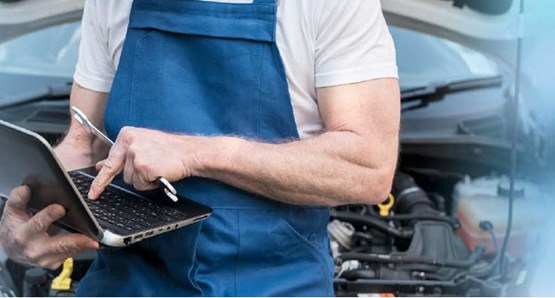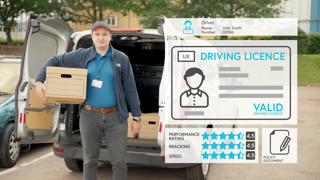Catherine Chetwynd explains the 7 things fleets need to know before selecting and implementing new fleet management software.
1 Software can improve compliance

The centralised and automated recording of the disparate elements of fleet management which software allows ensures that all management information is in one place and immediately accessible to fleet managers.
Driving licence checks, MOTs, training and more can be recorded, with automated reminders sent via text and email to ensure the information remains current.
Details such as licence validation, vehicle servicing and MOT documentation can be fed into the Driver and Vehicle Standards Agency (DVSA) database with minimal human intervention.
Dependent on the system, the software can also provide a comprehensive and holistic record of activity, something that will become even more important with the introduction of the General Data Protection Regulation (GDPR) in May.
Also, the Fleet Operator Recognition Scheme (FORS), the Freight Transport Association Van Excellence scheme and DVSA Earned Recognition Scheme (being piloted), although voluntary, all raise the standards of fleet operation but increase the need to record actions that prove compliance to those standards, rendering hand-written records inadvisable and nigh on impracticable.
Fleet management software provides a clear, concise and automated audit of all fleet-related activity and shows companies are adopting the GDPR principles of transparency and accountability, backed by proof that they have obtained individuals’ consent to use all the data they have collected.
2 Software can be tailored to the size and type of your fleet

Buying a fleet management system that handles current requirements is not enough. The package should be configurable and modular to ensure it moves with the times and your needs.
Not only may a fleet either grow or reduce in size and change in vehicle profile, but legislation and industry standards will also change and it is essential that incumbent software is able to respond without having to be replaced – neither major investment nor disruption should be necessary.
The size of fleet is not the driving factor because duty of care, risk management, safety and legislative demands are common to all, although the amount of data to be collected, processed and analysed increases with the size of the fleet.
As a result, there is technology to run a fleet of five on one platform to 5,000 vehicles spread across several companies, countries, currencies and continents.
Those with a single-digit fleet could go for entry level solutions, with a view to stepping it up as the fleet grows.
Fleet management tools should integrate seamlessly with HR, finance, payroll, external systems such as fuel and maintenance cards, electronic purchase transactions, telematics, DVLA and HMRC.
A good supplier’s standard set-up should be predicated on best practice, so start with the basic and see whether it covers most of your needs, then look at what else would be useful and what it will take to provide it.
A bespoke design is not usually desirable as it is an inflexible and short-term fix, whereas a modular system is sustainable, caters for changing needs and ensures that all elements of a vehicle’s lifecycle are covered, from vehicle maintenance and driving infringements to policy reviews and complaints protocol.
Upgrades should perpetuate any changes made when the programme is installed.
3 How to select the right software package

Given the number of modules available from some suppliers, choosing the right software to run your fleet is akin to negotiating a minefield.
First and foremost, buyers should work out exactly what they need: what data do they want to collect, how and to what level it should be analysed, the processes and protocols the system should run, etc.
Document the vehicle’s life from start to finish and decide how much of that should be automated – probably all of it because no factor exists in isolation and the data can be combined to give an invaluable holistic view and an audit trail.
Then assess what you will need in three, five, seven years’ time, so you are catering for cultural and technological progress.
Having done that, you will have a good idea of the scale of the task, allowing you to transmit that to potential suppliers in an RFP (request for proposal). Definition is all.
While outlining the component parts, it is worth examining what you have done to date to identify any outdated practices, so you can cater for that in the RFP.
And when you want to change what your existing programme does, beware of looking for technology that mirrors what you have: the new software should give best cost and efficiency benefits; and do not update old tender documents – your company and the market have almost certainly moved on.
Splendid isolation is also not the way forward, so consult companies that are using your preferred system and then ask to see it in situ, so you can experience it operating live.
All-round communication is crucial – talk to suppliers and glean information from them about what they have, what they are planning and how the tools have worked for their existing customers.
4 Software can improve safety and duty of care

Fleet management software can play an important role in improving employee and vehicle safety.
For example, it can be used to record daily vehicle checks to ensure they are roadworthy, as well as maintenance records.
A system can point out that a service is overdue, an MOT test is due and vehicle checks are being undertaken regularly – and all can be visible on one screen.
Managers should be able to set and prioritise alerts, so that they are informed of potential lapses in duty of care; for example, where strong enforcement is required, a fleet manager can be notified where a moving vehicle has not been inspected.
Prioritising is essential. It is easy to become bogged down with data to the extent that the temptation is to do nothing with it, which can quickly become habit.
Less, but honed, data provides greater value.
If this is crucial for standard fleets, it is even more important for grey fleets, which are subject to the vagaries of owner subjectivity.
Anything that increases efficiency and makes it easier for employees to submit details such as vehicle insurance, VED, MOT and servicing means employers are protecting themselves legally and safeguarding their image; risk and reputation management are inseparable.
It also means they can demonstrate to customers that their fleet is safe and compliant.
5 Software can reduce the burden of admin

Although a paperless society may still be a flight of fancy, it is an aspirational goal and anything that does away with spreadsheets tends to be more efficient.
Fleet management software collects, organises and displays information in real-time and makes it easily accessible. As fleet administration continues to intensify, this is increasingly relevant.
Apps allow mobile devices to enter the picture, ensuring drivers have little excuse for not providing the information required and allowing immediate and automatic communication directly with drivers.
It also removes the need for manual intervention unless instant action is called for.
This makes regular updating of information part of company culture and allows it to be included in contracts of employment, codes of conduct and job descriptions.
It should be possible to automate almost everything in the lifecycle of a fleet: adding, allocating and updating jobs, the clocking on and off of employees, logging and updating of vehicle defects, maintenance history and service schedules with details of work done/to be done.
In addition, paper forms can be replaced by online versions, including inspection sheets, and self-service records such as pool car availability and use, accident/incident forms, etc.
This also removes the likelihood that fragmented physical data leads to loss or duplication of information, giving a collated and accurate fleet profile that is instantly accessible to all parties.
eConsent, approved by DVSA, and esignatures further ease the process. And if time is money, the time saved is worth a fortune.
6 Software can be regularly updated

Updating fleet management technology requires serious investment of time and money and should therefore bring a measurable return.
Changes in legislation, new business practices or product developments are all good reasons for doing so.
Problems with the existing arrangements are also a prompt to re-assess, particularly if it does not integrate with other software smoothly or is creating more problems than it solves, requiring greater human input rather than less.
The right system should allow a fleet department to take on more work without needing to increase the number of staff.
Whether updating means starting from scratch and emerging from a deluge of paper or moving on to the next generation of technology, the task has been alleviated by the elevation of many systems to the web or cloud, making it easy to implement, scalable and compatible with most other programmes, internal and external.
Any product that pushes a company into working differently because it cannot be adapted should be avoided, but if your existing provider undertakes ongoing product development and enhancements, upgrading should be painless.
However, keep in mind that moving information from one supplier to another may involve data reformatting – a gargantuan task if you are migrating from spreadsheet to software.
And keep an eye on the future; manufacturers will soon be putting telematics in vehicles as standard and devices will become ever smarter.
7 What to look for when choosing a supplier

As with any long-term relationship, partnering with a fleet management software provider requires considerable research.
Your partners will act as your support team, one that will ensure compliance and provide automation of that compliance.
The provider should actively and continually assess your requirements, giving not just value, but added value.
Research the market so you know what is happening in software development and talk to potential providers about how their system integrates with that of the wider world such as HR, finance, payroll, etc.
For this you need an API (application programming interface). Most cloud platforms are equipped with fully enabled API, but, without it, you will be constrained to working with one company.
Financial stability of the supplier is a prerequisite, product investment a must and high standards in the areas that matter to your company such as ISO accreditation for security, legislation compliance and DVSA compliance, for example, are essential.
Seek out an experienced account management team, take up references, talk to your peers and look for a proactive user group – there is nothing more valuable than hearing from those who have done the empirical research.
Where you consult clients of your intended supplier, see the technology in action and talk to those who are using it – both fleet managers and drivers, so you get management and coalface reviews.
When you are confident you have found a potential partner, trial your chosen system so you have hands-on experience and get feedback from those in your company who will be using it.
Do not ignore cultural differences: if your organisation is forward thinking, your supplier should be equally progressive; equally, if your company tends towards the conservative, your provider needs to think likewise.
When you first meet them, make sure those who attend a presentation to your business are also those who will be working on the account – it’s important that you like and get on with them.
Although all parties hope there will not be any major problems, it is still worth knowing who you can turn to higher up the management chain, if necessary.
And just as you want to feel valued as a customer, so your supplier wants to feel valued – they are an extension of your department and should be treated as such.

By Martin Evans, managing director, Jaama
Jaama is the UK’s leading fleet and asset management software provider and continues to push the technological and functionality boundaries to ensure companies operate at the cutting-edge of data management, operational best practice and compliance.
In the past decade many fleet decision-makers have woken up to the fact that hi-tech fleet management systems, such as Jaama’s multiaward-winning Key2 technology, can seamlessly interact with other internal and external software to dramatically improve operating effectiveness and efficiency.
What’s more, the development of smartphone apps ensures the very latest data is always available. For example, Jaama’s My Vehicle App with auto-triggering means all information uploaded by drivers automatically updates their employer’s Key2 system. Such technology advances mean so-called ‘big data’ is not imminent; it is here.
It is vital businesses have in place good systems that will take vehicle and driver information and digest it. In turn, that will enable fleet managers to make better informed decisions as they will have a holistic picture. The age of paper documents is over and should be confined to the waste bin. Anglian Water is one business that has recognised that industry- leading software will make running its fleet more efficient and with a swift return on investment.
The utility company has described Key2 as a “game-changer” saying it is “investing in the future” and will reap efficiency and financial benefits as the technology enables the business to analyse outcomes and “understand what excellent fleet performance looks like and how we can make it even better”.
With the rapid advance of technology and data it is critical that other organisations are not stuck in the fleet management software slow lane. For further information: web – www.jaama.co.uk; email – enquiries@jaama.co.uk; telephone – 0844 8484 333.


















Login to comment
Comments
No comments have been made yet.